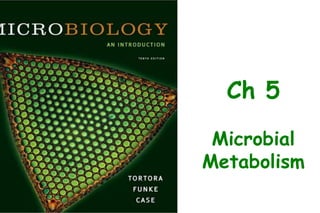
Lec 4.ppt
- 2. Objectives: • Differentiate between, anabolism, and catabolism. • Explain what is meant by oxidation– reduction. • Describe the chemical reactions of glycolysis. • Explain the products of the Krebs cycle.
- 3. Metabolism The entire spectrum of chemical reactions that carried out in the cell and hydrolyzed by enzymes. • Anabolism is related with the synthesis of complex molecules and polymers from simpler ones with consumption of energy. • Catabolism is related with the breakdown of polymers and molecules into simple forms with the release of energy.
- 5. Energy Production: Oxidation-Reduction Reactions • Oxidation = removal of e - • Reduction = gain of e - Redox reaction = oxidation reaction paired with reduction reaction.
- 6. Oxidation-Reduction In biological systems, the electrons are often associated with hydrogen atoms. Biological oxidations are often dehydrogenations.
- 7. The Generation of ATP Phosphorylation: 1. Substrate level phosphorylation: transfer of a high-energy PO4 – from another phosphorylated compound to ADP. 2. Oxidative phosphorylation: transfer of electrons from one compound (frequently NADH which acts as an electron carrier)to another is used to generate ATP by chemiosmosis. 3. Photophosphorylation: Associated with photosynthesis), the electrons are obtained from light-activated pigments
- 9. The energy generated by catabolic reactions is utilized by the cells for: Biosynthetic processes Repair Transport of nutrients across the cell membrane DNA replication Protein synthesis etc.
- 10. Most of medically important microbes are chemoheterotrophs which catabolize organic compounds (sugars, fats and proteins) to release energy. The most common form of organic compound used by microbes as carbon and energy source are complex carbohydrates.
- 11. Complex carbohydrates include: • Starch • Cellulose • Oligosaccharides • Tri and di- saccharides made up of glucose units. These polymers are first enzymatically broken down to their monomer form, a six carbon sugar called glucose.
- 12. Metabolic Pathways of Energy Production: COH Catabolism • Cellular respiration – Aerobic respiration – Anaerobic respiration • Fermentation The three steps of aerobic respiration 1.Glycolysis (oxidation of _____ to ______) 2.Krebs cycle (oxidation of acetyl CoA to ___) 3.Oxidative phosphorylation (e- transport chain)
- 13. Glucose is further broken down by various pathways with release of energy which ultimately results in the formation of energy rich compounds like: ATP Reduced coenzymes (NADH, NADPH, FADH2).
- 14. Embden-Meyerhof-Parnas (EMP) pathway (Glycolysis) The most common pathway present in all medically significant microbes. It is functional in the absence or presence of oxygen. Involves ten enzyme-catalyzed reactions located in the cytoplasm of the cells. Two reactions are energy driven and three reactions release energy.
- 15. Seven steps are reversible and three are irreversible reactions involving (the pathways 1, 3, 10) hexokinase, phosphofructokinase and pyruvate kinase. This pathway results in generation of pyruvate (a 3-carbon sugar) and energy rich compounds ATPs and NADPH.
- 18. TCA cycle Under aerobic conditions pyruvate is further catabolized into various intermediates via enzymes of Krebs cycle, also called TCA cycle. The latter cycle is present in many bacteria, fungi, yeasts, algae and higher forms of eukaryotic cells. Initially pyruvate is decarboxylated to a two carbon compound as shown under:
- 19. Acetyl CoA then enters TCA cycle by combining with oxaloacetic acid to form citric acid. The latter molecule is a six carbon compound which gets converted into oxaloacetic acid through a series of reduction and decarboxylation reactions. The net reaction of TCA cycle is as follows:
- 20. TCA cycle is also a source of generating ATPs though in a limited amount. TCA cycle should not be seen only as a catabolic pathway but also as a major source of C4 and C5 intermediates which are required for the synthesis of amino acids and nucleotides. In contrast to fermentation reactions which occur in the cytoplasmic matrix TCA cycle operates in the mitochondrial complex in close proximity to respiratory cycle. The reduced coenzymes like NADH generated during TCA cycle and other fermentation reactions produce ATPs once they enter respiratory cycle.